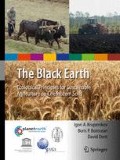Abstract
If we consider the history of the chernozem on a time scale comparable to human history, then the pre-Holocene is its prehistoric period, the Holocene its ancient history, the last 5000–10,000 years its modern history and the time from the middle of the nineteenth century up till now the most recent – and cataclysmic – period. The ancient history of the chernozem took place under steppe vegetation; around the northern shores of the Black Sea, sediment laid down and subsequently exposed by the advance and recession of the sea show cycles of chernozem formation with all the features of modern Calcareous chernozem. The development of Common chernozem, in which carbonates are leached to 0.5 m, clearly takes a long time; the two varieties co-exist in the landscape. Profiles buried beneath Trajan’s Bank, about 2000 years ago, represent both Calcareous chernozem and Common chernozem, testifying to a period of soil formation of 4000–5000 years up to the beginning of the modern period. For 18 centuries after Trajan, farming on the steppe was quite limited. Long grass fallows were practised and historical testaments to the fertility of the country probably reflect the achievement of a stable equilibrium under the contemporary factors of soil formation. But in the most recent period, under the assault of increasingly exploitive agriculture, the resilience of the black earth has been depleted by loss of humus and loss of the topsoil itself by erosion. Four possible futures are considered:
– Back to nature: stopping chemical agriculture and allowing the soil to regenerate itself. This ignores the question of daily bread for a world population of 9 billion by 2050, which will require a doubling of world food production, and the fact that natural regeneration of soils is sluggish
– Business as usual, which will mean erosion of all sloping land within a few decades, widening of the negative humus balance with the balance of available nitrogen and phosphate also becoming sharply negative. It is very likely that this scenario will prevail in the near future. For Moldova this might mean yields falling to 2.1 t/ha of wheat/ha and 2.8 t/ha of maize in 2025 – that is half the level of the 1960s
– A sceptical scenario that aims to arrest rather than reverse the degradation, for instance, by retiring eroded land to forest or pasture
– An ecologically well-balanced scenario to secure enhancement of present levels of fertility and environmental services. This would involve accurate, compensating practices – applying enough farmyard manure, the best possible return of straw to the soil, grass leys, minimum tillage and addition of fertilizers. The results of the long-term experiments at Selectia Experimental Station show how well the chernozem can respond. The aim will be a chernozem lower in humus than the pristine steppe soil but, all the same, a resilient chernozem with its favourable organic matter, adsorption complex and neutral reaction, and rich in nutrient reserves
Access this chapter
Tax calculation will be finalised at checkout
Purchases are for personal use only
Notes
- 1.
Trajan’s Bank comprises two sets of earthworks that extend across the south of the country marking the furthest extent of the Roman Empire in the reign of the Emperor Trajan early in the second century AD.
- 2.
World Commission on Environment and Development (1987).
References
Adamenko OM, SI Medianic and NF Mirlean 1989 Climate reconstruction in the south of Moldova using the methods of Palaeontology and geochemistry. 66–73 in palaeogeography and lithology. Stiinta, Chisinau (Romanian)
Alexandrovski AL 1983 The evolution of the soils of the Western European Plain in the Holocene. Nauka, Moscow 150p (Russian)
Alekseev VE 1999 Mineralogy of soil formation in steppe and forest-steppe zones of Moldova: diagnosis, parameters, factors, processes. Stiinta, Chisinau, 240p (Russian)
Alekseev VE 2003 On the age of soils and soil formation in the territory of Moldova. 41–51 in SV Andries (editor) Soil – one of the main problems of the 21st Century. International scientific and practical conference on the 50th anniversary of the Nicolai Dimo Research Institute for Soil Science and Agrochemistry. Pontos, Chisinau (Romanian)
Andries SV and Zagorcea CL 2002 Soil fertility and agricultural service in agriculture, Bulletin of the Academy of Sciences of Moldova: Biological, Chemical and Agricultural Sciences, Chisinau 2, 42–44
Conea A 1970 Loesses and paleosols in Dobrojea. Ceres, Bucharest, 234p (Romanian)
Dobrovolsky GV and ED Nikitin 1990 Soil functions in biosphere and ecosystems. Nauka, Moscow, 253p (Russian)
Genadiev AN 1990 Soils and time: models for development. Nauka, Moscow 220p (Russian)
Krupenikov IA 1967 Chernozem of Moldova. Cartea Moldoveneasca, Chisinau, 427p (Russian)
Krupenikov IA (editor) 1981 Statistical parameters for soil composition and properties in Moldova Vol. 2. Stiinta, Chisinau, (Russian) 253p
Krupenikov IA 1992 Soil cover of Moldova. Stiinta, Chisinau, 264p (Russian)
Krupenikov IA 1960 Soils down Trajan’s Bank and some issues of palaeopedology. 55-69 in Nature Conservation of Moldova. Vol. 1, Stiinta, Chisinau (Russian)
Mengel K 1981 Wesentliche factoren der bodenfruchtbarkeit. Bodenkultur 32, 9, 189–194 (German)
Screabina IE 1972 The process of clayization in chernozem soils of Moldova (short version of dissertation) MV Lomonosov State University, Moscow, 28p (Russian)
WCED 1987 Our common future. World Commission on Environment and Development. Oxford University Press Oxford
Author information
Authors and Affiliations
Rights and permissions
Copyright information
© 2011 Springer Science+Business Media B.V.
About this chapter
Cite this chapter
Krupenikov, I.A., Boincean, B.P., Dent, D. (2011). The Past, Present and Future of the Chernozem. In: The Black Earth. International Year of Planet Earth. Springer, Dordrecht. https://doi.org/10.1007/978-94-007-0159-5_19
Download citation
DOI: https://doi.org/10.1007/978-94-007-0159-5_19
Published:
Publisher Name: Springer, Dordrecht
Print ISBN: 978-94-007-0158-8
Online ISBN: 978-94-007-0159-5
eBook Packages: Earth and Environmental ScienceEarth and Environmental Science (R0)

